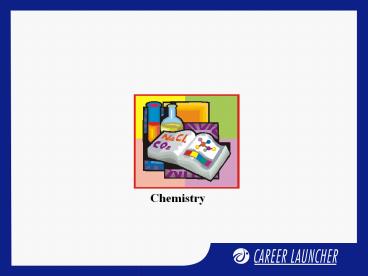GENERAL ORGANIC CHEMISTRY - 5 PowerPoint PPT Presentation
1 / 48
Title: GENERAL ORGANIC CHEMISTRY - 5
1
(No Transcript)
2
Session
GENERAL ORGANIC CHEMISTRY - 5
3
(No Transcript)
4
Session Objective
1. Fission of a covalent bond homolysis and
heterolysis 2. Reaction intermediates
carbocations, carbanions and free
radicals 3. Different reagents electrophiles,
nucleophiles and carbene 4. Brief idea about
type of organic reactions substitution,
addition, elimination,condensation,
rearrangement, isomerisation
5
Reaction Mechanism
6
Bond Cleavage
Heterolytic Cleavage
vely charged ion carbocation -vely charged
ion carbaanion
Homolytic Cleavage
Free radicals.
7
Carbonium ion
- Planar sp2 hybridised bond angle 120o
- Has six electrons
- Stabilized by resonance or inductive effort or
hyperconjugation
8
Examples of Carbonium ion
9
Stability of Cabocation
The resonance effect is always more predominant
than the inductive effect in stabilizing an ion.
(i) By inductive effect
10
Stability of Cabocation
(ii) By hyperconjugation
Thus, tertiary carbocation is more stable than
secondary and so on.
11
Carbanion
- Pyramidal - sp3 hybridised bond angle 109.28
- Has eight electrons
- Stabilized by resonance or by inductive effect.
12
Stability of Carbanion
(i) By resonance
13
Stability of Carbanion
(ii) By inductive
14
Stability of Carbanion
(iii) Electron-donating groups destabilize a
carbanion while electron-withdrawing groups
stabilize it.
15
Free Radical
- Planer or Pyramidal
- Has seven electrons
- Stabilized by resonance or by inductive effect.
- Order of stability of free radical 3o gt2ogt 1o
16
Classification of Reagents
Nucleophilic Reagents (Nucleophiles)
- Attacks the positive end of a polar bond or
nucleus-loving is known as nucleophile. - Generally, negatively charged or electron rich
species are nucleophilic.
- All nucleophiles are in general Lewis bases.
17
Classification of Reagents
Electrophilic Reagents (Electrophiles)
- Attacks a region of high electron density or
electron-loving is known as electrophile. - All positively charged or electron deficient
species are electrophilic.
18
Classification of Reagents
- Neutral reagents which contain an
electron-deficient atom are also electrophiles.
AlCl3, SO3, BF3, SOCl2, POCl3, FeCl3, ZnCl2
- All electrophiles are in general Lewis acids.
19
Carbenes
- Divalent carbon compound.
- Carbon atom is linked to two adjacent groups by
covalent bonding. - A carbene is neutral and possesses two free
electrons, i.e. a total of six electrons. - Electron deficient.
20
Carbenes
Carbene is of two types
21
Types of Organic Reaction
Substitution Addition
Elimination Rearrangement
Condensation Isomerisation
22
Types of Organic Reaction
Substitution Reaction
Replacement of an atom or group byother atom of
group
Nucleophilic substitution
SN1 Reaction Unimolecular nucleophilic
substitution reaction.
23
Types of Organic Reaction - SN1 Reaction
(1)
(2)
24
Types of Organic Reaction - SN2 Reaction
SN2 Reaction This is called bimolecular
nucleophilic substitution and it is one-step
process.
25
Addition
26
Elimination Reaction
Two groups on adjacent atoms are lost as a double
bond is formed.
We divide elimination reactions into three
classes.
(1) E1 (2) E1 CB (3) E2
27
Rearrangement
- Migration of a group takes place within the same
molecule.
(Beckmann rearrangement)
(Dehydration and rearrangement)
28
Condensation
Two molecules of same or different reactants
combine to give a new product with the
elimination of simple byproducts like H2O, NH3,
etc,
29
Isomerisation
30
(No Transcript)
31
Class Exercise 1
32
Solution
This carbocation is highly stabilised through
resonance with three benzene rings.
Hence answer is (b).
33
Class Exercise - 2
34
Solution
Hence answer is (d).
35
Class Exercise - 3
Which of the following is the most effective
group in stabilizing a free radical
inductively? (a) F (b) I (c) Br (d) Cl
36
Solution
Since free radical is electron deficient, any
substituent with more electron releasing and less
electron withdrawing ability will stabilize the
radical inductively. The decreasing order of
electronegativity of halogens is F gt Cl gt Br gt I
Hence answer is (b).
37
Class Exercise - 4
Which of the following is not a nucleophile? (a)
CN (b) BF3 (c) RNH2 (d) OH
38
Solution
Among the following, BF3 is only electron
deficient. Hence, it will not act as a
nucleophile.
Hence answer is (b).
39
Class Exercise - 5
Which of the following is the correct order
regarding I effect of the substituents? (a)
NR2 gt OR gt F (b) NR2 gt OR lt F (c) NR2 lt
OR lt F (d) OR gt NR2 gt F
40
Solution
I effect increases with electronegativity of
atom. The decreasing order of electronegativity
is F gt O gt N \ The correct order for I effect
is NR2 lt OR lt F
Hence answer is (c).
41
Class Exercise - 6
42
Solution
Among the following, (a) is stabilised through I
effect and (b) is destabilized through I effect
of phenyl ring. Other two are stabilised through
resonance.
Hence answer is (c).
43
Class Exercise - 7
44
Solution
Hence, stabilised through I effect of CH3 group
which decreases with distance. (c) is more stable
as compared to (b). (d) is most stable as it is
tertiary cation and stabilised through I effect
of CH3 group and hyperconjugation. \ The order
is (d) gt (c) gt (b) gt (a)
45
Class Exercise - 8
46
Solution
Radicals are stabilised through electron
releasing resonance and inductive effect.
More resonating structure
47
Solution
One resonating structure, although both are
primary radicals.
48
(No Transcript)

